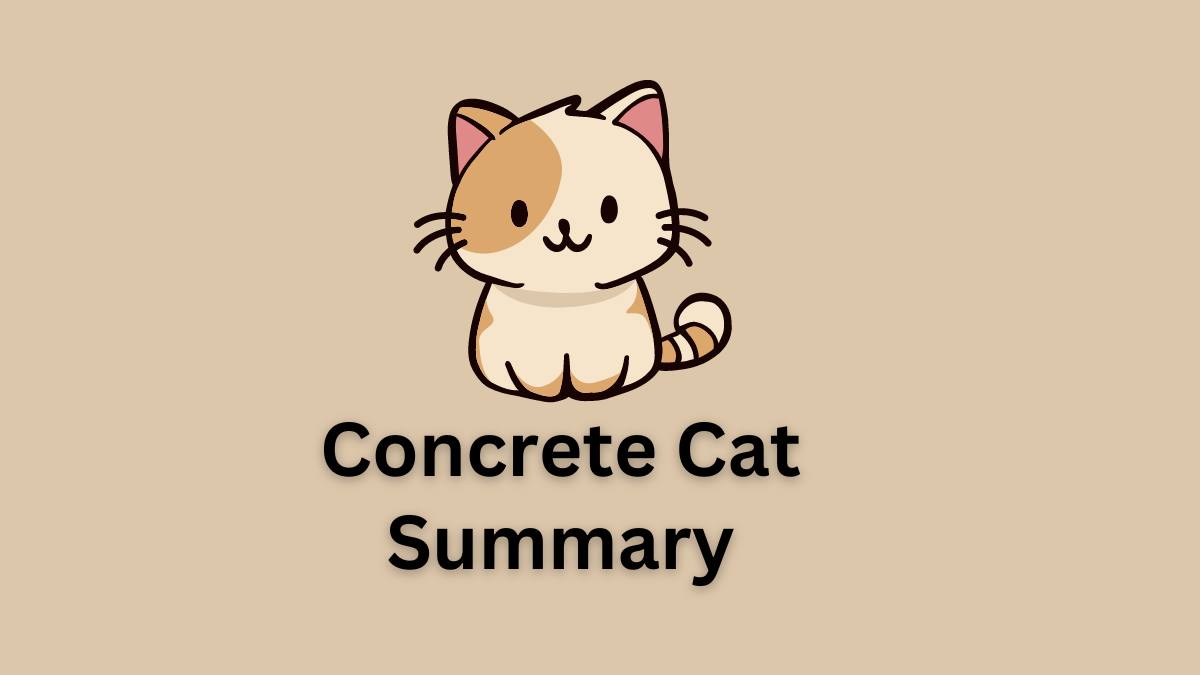Concrete Cat Summary
“Concrete Cat,” written by Dorthi Charles, is a distinctive example of a concrete poem, where the visual presentation of words on the page is paramount. This poem is crafted for the eyes, not to evoke deep emotions or thoughts.
The arrangement of letters and words forms a visual image of a cat, emphasizing its physical appearance over traditional poetic elements like rhythm, rhyme, or emotional depth.
In “Concrete Cat,” the poet cleverly uses typography to create the cat’s features. For instance, the capital ‘A’ in “ear” represents the cat’s pointed ears, while the capital ‘Y’ in “eye” signifies the cat’s wide-open eyes. The capital ‘U’ in “mouth” suggests the cat’s hanging tongue, hinting at its greediness. Additionally, the word “Tail,” spaced out, indicates the cat’s striped tail, showcasing its black and white pattern.
One of the poem’s unique aspects is its use of puns and wordplay. The middle stripe of the cat’s body can be read as “stripes,” referring to the cat’s fur pattern, and “tripes,” which means the stomach lining of an animal.
This dual meaning adds a layer of humor and creativity to the poem, highlighting the cat’s predatory nature and its recent meal, a mouse.
The poem also includes an upside-down word “mouse,” symbolizing that the mouse has been killed by the cat. Nearby, there is a litter box, indicating the domestic environment of the cat. These details not only form the visual image of the cat but also give hints about its actions and surroundings.
“Concrete Cat” breaks away from traditional poetry, which often follows structured stanzas and rhythmic patterns. Instead, it uses visual artistry to convey meaning.
The words are arranged in different shapes and sizes, creating a picture that immediately conveys the essence of the cat. This approach prioritizes outer appearance and physical structure over emotional and thematic depth.
Unlike conventional poems, which might use ornamental language and evoke strong emotions, “Concrete Cat” is all about visual representation.
It is designed to be seen and appreciated for its form rather than felt for its content. The poem’s primary concern is the physical appearance of the text, making it a unique and engaging piece of visual poetry.
Read More: Summary of The Poplar Field
In summary, “Concrete Cat” by Dorthi Charles is a fascinating concrete poem that uses the arrangement of letters and words to create a vivid image of a cat. It focuses on visual structure and playful word arrangements, offering a fresh and innovative approach to poetry.
This poem is a beautiful example of how words can be used to create art, appealing directly to the eyes and imagination of the reader.
Read More: Summary of “The Three Day Blow”
Important Questions and Answers
What is the main focus of a concrete poem like “Concrete Cat”?
The main focus of a concrete poem is the visual presentation. It is crafted to create a specific image or shape on the page, prioritizing physical appearance over traditional poetic elements like emotions, thoughts, or structured language.
How does the poet use letters and typography to represent the cat’s features?
The poet uses capital letters and spacing creatively to represent the cat’s features. For example, the capital ‘A’ in “ear” indicates pointed ears, the capital ‘Y’ in “eye” signifies wide-open eyes, and the capital ‘U’ in “mouth” represents the hanging tongue. The spaced-out word “Tail” suggests the striped pattern of the cat’s tail.
What is the significance of the upside-down word “mouse” in the poem?
The upside-down word “mouse” signifies that the mouse has been killed by the cat. It visually and symbolically represents the cat’s predatory nature and recent action of killing the mouse.
What dual meanings are suggested by the word “stripes” in the middle of the cat’s body?
The word “stripes” has a dual meaning: it refers to the striped fur pattern of the cat, and it also plays on the word “tripes,” which means the stomach lining of an animal. This pun adds a humorous and creative layer to the poem, indicating the cat’s recent meal.
How does “Concrete Cat” differ from traditional poems?
“Concrete Cat” differs from traditional poems by focusing on visual representation rather than emotional or thematic depth. It uses the arrangement of words and letters to create a picture of a cat, emphasizing form over content. Unlike conventional poems that follow structured stanzas and rhythmic patterns, “Concrete Cat” is designed to be seen and appreciated for its visual artistry.
Read Next: Summary of Unchopping a Tree
